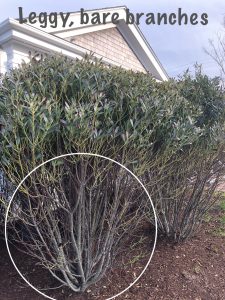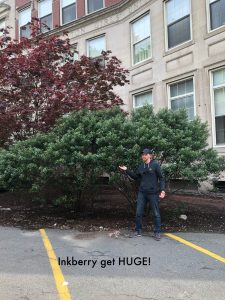Inkberry, Ilex glabra, is a beautiful, rounded, evergreen shrub that grow 5 – 8′ tall. It prefers full sun and evenly moist acidic soil, but does well in wet areas and light shade. When properly pruned, inkberry can make a nice foundation plant or short hedge, but is best used in native screens and rain gardens, where it can be left to grow naturally with little intervention needed from the gardener. Young plants are perfectly round, with leaves right to the ground. As plants mature, however, the canopy tends to shade out the bottom portion of the plant and their lower branches can become bare and leggy. Regular pruning is required to keep inkberry looking its’ best.
Most applications for inkberry call for a plant that is maintained at 3-4 feet. Once they reach this size, they need to be pruned at least once a year to keep in bounds. Shearing with hedge trimmers (when new growth has just hardened off in early summer) is the easiest way to prune rounded shrubs. Although this approach takes the least amount of time, repeated cycles of shearing can make the surface of the plant very dense, shading out the lower branches. I recommend doing a more thorough pruning procedure every other year to open up the plant. More light penetration stimulates new growth at the base and keeps the plant healthier overall. Should plants become overgrown and overly leggy, a renovation can be done during the dormant period in winter or early spring. I’ve actually cut overgrown inkberry to the ground while dormant and had excellent results.

There are several objectives when doing regular pruning on inkberry:
- To remove dead or damaged branches
- To maintain the proper height and shape
- To keep the plant green from the ground up, (not leggy)
Understanding the growth pattern of these plants helps the gardener when making pruning decisions. Growth in the upper portion of inkberry plants occurs in whorls. A whorl is a ring of new stems that grow around a central, upright stem. There are many dormant buds between whorls on bare portions of the stems, even on the oldest woody stems.
 On off years, when plants are not sheared, follow these guidelines:
On off years, when plants are not sheared, follow these guidelines:
- Remove any dead or dying branches completely, where they meet healthy growth.
- Pinch out most of the previous seasons’ growth just above a whorl to thin out the surface and keep the plant at the best height.
- Most cuts are made in the previous season’s growth, but several cuts can also be made into older wood, to stimulate growth lower down.
- As plants age, some of the oldest branches can be removed entirely at ground level in favor of younger, more vigorous growth.
There are several varieties of Inkberry available in the trade. The most common are ‘Compacta’ ‘Densa’ and ‘Shamrock’. Of the three, ‘Shamrock’ is the most highly praised by Dr. Michael Dirr in his extensive text book Manual of Woody Landscape Plants.
